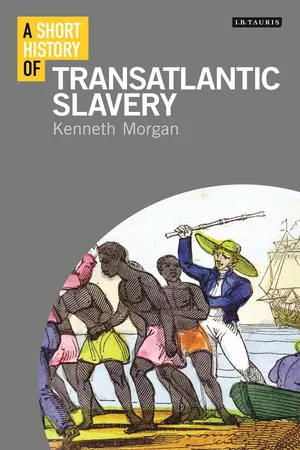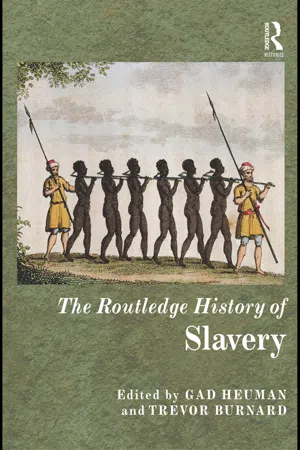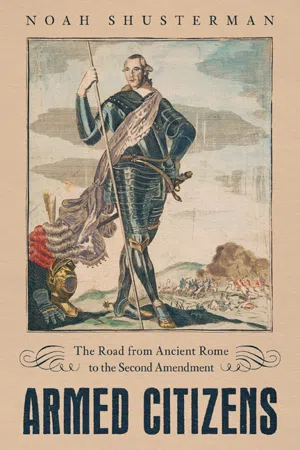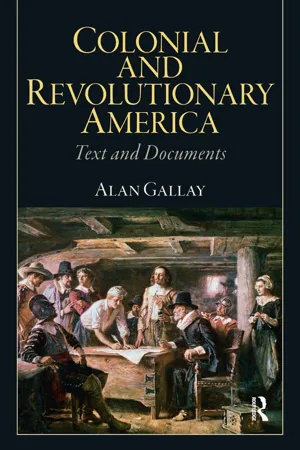History
Stono Rebellion
The Stono Rebellion was a significant slave uprising that took place in South Carolina in 1739. It was one of the largest and most successful slave rebellions in the British mainland colonies. A group of about 20 slaves armed themselves and marched toward Spanish Florida, where they hoped to find freedom. The rebellion was brutally suppressed, leading to stricter slave codes and harsher treatment of slaves in the region.
Written by Perlego with AI-assistance
Related key terms
6 Key excerpts on "Stono Rebellion"
- eBook - ePub
Stono
Documenting and Interpreting a Southern Slave Revolt
- Mark M. Smith(Author)
- 2019(Publication Date)
- University of South Carolina Press(Publisher)
NTERPRETING STONOPassage contains an image Essay 1
ANATOMY OF A REVOLTPeter H. WoodPeter H. Wood, professor of history at Duke University, offered the first modern historical account of the Stono Rebellion. Wood’s work—first published in 1974—has stood the test of time very well. It is the classic interpretation and account of the rebellion, and it remains the touchstone for anyone writing on the topic. Wood places the revolt in context, thinks carefully and imaginatively about causes and timing, and explains the impact of the revolt and its local and larger significance. Although other historians of the Stono Rebellion sometimes disagree with Wood, they are clearly indebted to his work on the topic. More than any modern historian, Peter Wood identified the importance of the revolt and opened up the question for further research.In September 1739 South Carolina was shaken by an incident that became known as the Stono Uprising. A group of slaves struck a violent but abortive blow for liberation that resulted in the deaths of more than sixty people. Fewer than twenty-five white lives were taken and property damage was localized, but the episode represented a new dimension in overt resistance. Free colonists, whose anxieties about controlling slaves had been growing for some time, saw their fears of open violence realized, and this in turn generated new fears.According to a report written several years later, the event at Stono “awakened the Attention of the most Unthinking” among the white minority; “Every one that had any Relation, any Tie of Nature; every one that had a Life to lose were in the most sensible Manner shocked at such Danger daily hanging over their Heads.” The episode, if hardly major in its own right, seemed to symbolize the critical impasse in which Carolina’s English colonists now found themselves. “With Regret we bewailed our peculiar Case,” the same report continued, “that we could not enjoy the Benefits of Peace like the rest of Mankind and that our own Industry should be the Means of taking from us all the Sweets of Life and of rendering us Liable to the Loss of our Lives and Fortunes.”1 - eBook - ePub
- Kenneth Morgan(Author)
- 2016(Publication Date)
- I.B. Tauris(Publisher)
62The Stono Rebellion in South Carolina (1739) was the largest and only full-scale slave revolt in the history of the British mainland colonies in North America. It began on 9 September 1739 when a group of slave rebels broke into a store near the Stono River in a coastal parish twelve miles south of Charleston. Led by an Angolan called Jemmy, the rebels beheaded two white men, seized weapons and alcohol, and headed southwards towards Florida. Gathering between fifty and a hundred recruits along the way, they marched with drums and banners, and destroyed plantation houses and farms. By the afternoon they had reached the Edisto River where they paused, hoping extra black recruits would flock to their cause and make them invincible. This gave the white militia time to organize an attack on the rebels, to muster quick support from local planters, and to erect pickets at strategic crossroads and ferry crossings. By the evening, most of the black resistance had been quelled. However, some slave rebels escaped and the whites concentrated their efforts on hounding them down. During the rising at least twenty white people and forty-four blacks died.63The causes of the revolt remain speculative. Harsh conditions probably played a part. South Carolina had suffered from a bout of epidemic disease in the summer of 1739. That the Spanish garrison of St Augustine had offered freedom to Carolinian slaves shortly before the uprising broke out was perhaps of greater significance, owing to the proximity of South Carolina to the Spanish border and the fact that the Stono rebels headed south in that direction. This happened when Anglo-Spanish hostilities had spilled over into the War of Jenkins’s Ear, a largely colonial conflict caused by tensions over the safety of English and Spanish ships plying the Atlantic trade routes. This was a rising shaped by African tactics. Most rebels, including the leader, were Africans rather than Creoles. Many were of Congolese extraction. Their actions exhibited notable features of resistance associated with ethnic martial traditions in Africa. For instance, the initial decapitation of the two white men at the start of the revolt mirrored the common resort to displaying severed heads in African societies as trophies of military prowess. The use of banners and drums as the Africans marched south from Stono was integral to fighting methods followed in west-central Africa. It may be that some rebels had experienced war within Africa; this, after all, was how many slaves had been taken as captives before they were shipped across the Atlantic.64 - eBook - ePub
The Counter-Revolution of 1776
Slave Resistance and the Origins of the United States of America
- Gerald Horne(Author)
- 2014(Publication Date)
- NYU Press(Publisher)
5The Stono Uprising
Will the Africans Become Masters and the Europeans Slaves?What was known as Stono’s Revolt—a mass uprising of enslaved Africans in September 1739 in South Carolina that led to the massacre of dozens of settlers—took place at a time of rising tension with Spain and increased restiveness by Africans, suggesting that the newest firewall that was Georgia was proving to be quite porous. The authorities thought that what instigated this frightful upsurge was the repeated proclamations issued at St. Augustine by His Catholic Majesty promising freedom to all Africans who deserted from the north.1 Perhaps if the massacres had been confined to the fiery border between Carolina and Georgia, the problem could have been contained. But Stono was simply part of a larger conflict between London and Madrid that stretched to Cartagena. London was unable to seize this city on the northern coast of South America, nor Cuba, while Madrid—despite significant aid from armed Africans—was unable to dislodge mainland settlers in Carolina and Georgia permanently. Nonetheless, one did not have to be far-sighted to envision that London had stumbled into a corrosive long-term problem unless it could neutralize or eviscerate the advantage accrued by His Catholic Majesty in arming Africans. Contrarily, heedlessly and perilously, manacled Africans continued arriving in the southeast quadrant of the mainland where the Union Jack fluttered, where they became ripe targets for recruitment by His Catholic Majesty.After the slaughter of twenty-nine settlers2 near the Stono River, viewed with stark suspicion was the delegation from Florida that had appeared just before this trailblazing event, supposedly with the aim of delivering a letter to General Oglethorpe—though it was generally known that he was in Georgia. An official report, after stressing that the “insurrection” actually “depended on St. Augustine for a place of reception afterwards,” pointed to the curiosity that the Spanish delegation bearing the letter included an African who “spoke English very well” and, presumably, briefed the insurrectionists.3 - eBook - ePub
- Gad Heuman, Trevor Burnard(Authors)
- 2010(Publication Date)
- Routledge(Publisher)
2005 ).There is an additional perspective on the Stono Rebellion that also reflects the importance of an African past. The Low Country of South Carolina was transformed in this period from a frontier society based on cattle herding to a plantation society producing rice. According to Edward Pearson, this fundamentally changed gender relations among the African slaves. Rice cultivation for the males violated their notions of the sexual division of labour: this was women’s work in western and west-central Africa. It was therefore an additional insult for the enslaved males to be forced to do this work, especially in light of their relatively autonomous existence as cattle herders. Additionally, as in the case of other rebellions, there were problems of disease in South Carolina: there had been a smallpox epidemic and then yellow fever, and there were also food shortages at the time of the outbreak (Pearson, 1996 ).Less than 30 years later, in 1760, African slaves in Jamaica led one of the largest revolts in the eighteenth-century Caribbean. The enslaved took advantage of the colonial forces having to fight elsewhere, as Britain was heavily involved in the Seven Years’ War against France and Spain. Apart from weakening the imperial forces, the war resulted in a significant reduction in the export of Jamaican sugar and in a doubling of the cost of imported provisions. As in the case of St John, it was Akan slaves who were involved in the rebellion. According to Edward Long, the eighteenth-century historian of Jamaica, the leader of the revolt was an Akan slave named Tacky, who was intent on “the entire extirpation of the white inhabitants; the enslaving of all such Negroes as might refuse to join them; and the partition of the island into small principalities in the African mode; to be distributed among their leaders and head men”.2 - eBook - ePub
Armed Citizens
The Road from Ancient Rome to the Second Amendment
- Noah Shusterman(Author)
- 2020(Publication Date)
- University of Virginia Press(Publisher)
might be available, was Oglethorpe, the “anonymous” author. It was Oglethorpe’s other activities that left a record, not his involvement—however marginal it may have been—in the Stono Rebellion. Again, the rebellion itself left few traces. And while part of this lack of evidence stems from white fears that news of the rebellion would spark another rebellion, that is not the only reason. By some measures, the Stono Rebellion was not that important.That verdict is not one all historians share. For Peter Wood, the rebellion hastened a “concerted counterattack” from the slave owners, as the earlier frontier society gave way to a plantation society. For others, including historians Michael Mullin and Eugene Sirman, the event lacked that importance.19 The deaths of twenty-five whites and fifty or so Africans mattered relatively little in the grand scheme of the colony’s history. A pair of epidemics around the same time had killed far more South Carolinians, white and black alike. Even Bull’s account makes the uprising seem merely a part of a larger conflict, that of England against Spain, played out in the New World as a battle between South Carolina and Florida. Those arguing for Stono’s unimportance would seem to be bolstered by the relative lack of information available about it. Again, Bacon’s Rebellion had produced far more documentation and far more inquiries from London. But then, Bacon’s men had torn apart the colony and burned Jamestown to the ground during an uprising that had lasted for several months.For understanding the history of colonial American militias, though, Stono merits as much attention as Bacon’s Rebellion. The two events showed different sides of the colonial militia. Bacon’s Rebellion showed, in its earliest forms, the emergence of what would be a long-term American pattern: citizen militias could be unstable. By arming its citizens and relying on those citizens to enforce the laws, Virginia had no way to enforce unpopular laws. Laws that divided the citizenry would divide the militia as well. Berkeley had little ability to impose his will on Bacon and his men. Bacon’s Rebellion also showed how white colonists could tolerate a significant amount of violence when that violence came from other whites. Many of the settlers who did not support Bacon were still unwilling to heed Berkeley’s call to fight against Bacon.20 Yet Britain’s North American colonies would continue to rely on militias, despite the instability that would occasionally result. There would continue to be uprisings among white colonists angry at government policies, and colonial governments would be similarly hamstrung in their responses—a pattern that would continue into the early years of the republic.21 - eBook - ePub
- Alan Gallay(Author)
- 2016(Publication Date)
- Routledge(Publisher)
Especially irksome to the planters was a long-standing offer from Spanish St. Augustine, who promised freedom to South Carolina slave runaways. The Spanish were not opposed to slavery, but resentful of English settlement on their land, particularly through settlement of Georgia, and saw the offer as a way to undermine their enemy. News of these pronouncements was carried by Indians who freely visited both colonies. English representations to the Spanish to end the offer of freedom fell on deaf ears.In September 1739, the Spanish invitation of freedom and slave discontent fomented into the Stono Rebellion. A group of 20 Kongolese slaves, who later attracted to their cause upwards of 80 or more, killed over 20 Europeans. The rebels met on the southern reaches of the colony to celebrate their actions and perhaps to wait for more to join them. But instead of continuing to St. Augustine and freedom, they stayed put, perhaps seeing their strength and believing they could conquer the colony. But the militia defeated the rebels, and in the aftermath, dozens of slaves were killed, their heads placed on poles at crossroads to warn others of the deadly consequences of rebellion.South Carolina enacted slave codes to secure colonists against their bondpeople. These codes became the model for future plantation regimes in the Lower South. They barred slaves from handling weapons and owning drums (which had been used by the rebels to signal one another). Meetings of slaves from different plantations were prohibited. Slaves had to carry passes when off the plantation and teaching a slave to read was outlawed, so they could not forge passes. The colony organized patrols to keep slaves on the plantation, and shored up the “watch” to prevent slaves from being out after dark in Charles Town. The legislature enacted laws to ensure that masters properly fed and clothed their servants, believing slaves were less likely to rebel if they received proper physical care. And since the Stono rebels had risen on a Sunday, while many whites attended church, white males were required to bring arms to church in case of another rebellion.
Learn about this page
Index pages curate the most relevant extracts from our library of academic textbooks. They’ve been created using an in-house natural language model (NLM), each adding context and meaning to key research topics.





